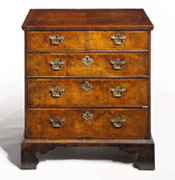|
18th Century English Furniture Still Available
By Anne Gilbert
Go figure this! There is supposedly more 18th century English furniture now
than the population at the time who would have used it. When you see examples at
shows, auctions and shops, the wood is beautiful, as are inlays and the figured
woods and carvings. Antique English furniture has always been something of a
status symbol, not only to wealthy Europeans but to Americans.
Granted, the
pieces you see at shows and quality shops are gussied up to look their best. But
hear this! The purist collector knows that the look of wear is important, such
as where the family dogs chewed on the leg means an authentic, not a reproduced,
antique.
However, for some reason American buyers want their antiques to look
new. The Brits know better. If all you are looking for is something that appears
to be English antique furniture, no problem. When big money is involved, the
finest antiques can and are being reproduced. Among the most expensive pieces
are those of painted and inlaid satinwood, showing the French influence on
English furniture makers in the third century. Runners up are early Queen Anne
pieces and Charles II.
CLUES: Look for signs of wear in obvious places. For
instance, on chairs, there should be wear on the arms and stretchers of a chair.
Think of how chairs were used. They were often dragged across the floor. Hence,
there should be scratches and some discoloring on the feet or the bottoms of the
legs. And when you move a chair, you touch it on the top. There should be some
discoloration from several centuries of being touched.
Beginning in the 19th
century, English furniture of earlier periods was continuously reproduced. Small
pieces such as Georgian lowboys were the most popular, as they are today. Next
were chests of drawers, Pembroke tables and chairs. When looking at English (or
any) antique furniture, first look at the style. A combination of styles could
be a reproduction or a revival piece.
It is important to familiarize
yourself with the style changes that happened toward the end of a period. Around
the turn of the 20th century, wealthy Americans bought up anything that looked
like English Queen Anne and George I, II, and III furniture. A common practice
of fakers of the era was to add faked, heavily carved legs to an old chair. Any
major alterations or replacements should lower the price. Consider that feet and
finials have often broken off over the years. While furniture refinishers can
work wonders, check for color differences that would point to restoration.
A
so-called "married piece" is often passed off for a hefty price. This usually
happens with a highboy, chest or bookcase desk. One of the problems with buying
on-line is not being able to do a hands-on examination. Are the brasses
original? How can you tell if you can't examine the inside of a drawer? Are the
saw marks proper for the period? Circular saw marks indicate a 19th century
piece. Eighteenth century marks should be cross-hatched. Since many countries
copied English furniture, a study of woods used is important.
While the
finest woods and graining were used on the outside of chests and bookcases, the
so-called secondary woods were placed where they couldn't be seen. It is these
woods that help identify the country of origin. For instance, fruitwood
interiors were used in European pieces, but not in England.
Another tip. Feel
under drawers and on the back of pieces that were meant to be placed against the
wall. In the 18th and early 19th centuries, they were left rough.
|

English Queen Anne chest of drawers, sold at Sotheby's, $3,900. (Photo:
Sotheby's.) |